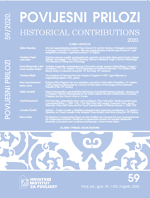Novija historiografija o grkokatoličkoj Marčanskoj (Svidničkoj/ Platejskoj) biskupiji i crkvenoj uniji u Hrvatskoj
Recent Historiography on the Greek Catholic Diocese of Marčanska (Svidnička / Platejska) and the Church Union in Croatia
Author(s): Zlatko KudelićSubject(s): History of Church(es), Modern Age, Recent History (1900 till today), Eastern Orthodoxy
Published by: Hrvatski institut za povijest
Keywords: historiography; Church union; Orthodox Church; Marčanska Diocese; Zagreb Diocese; Peć Patriarchy; Vienna court; Roman Curia; Croatian-Slavonian Military Frontier; Walachians;
Summary/Abstract: The author analyses Croatian and international historiography on the Greek Catholic diocese of Marčanska (Svidnička or Platejska) since the early 1990s, emphasizing that the increased interest in this topic at that time was partly driven by the political changes in Croatia and its surroundings. The topic has been in the focus of interest of historians dealing with the Military Frontier (Krajina) and the Catholic Church as well as authors of the syntheses of the history of Croatia and the Serbian Orthodox Church in Croatia. A number of scholars in Croatia have accepted J. Šimrak’s conclusions about the success of the union in the early 17th century as a consequence of the wider Union movement and the responsibility of the Vienna court and some Zagreb bishops for its failure. On the other hand, foreign historians have accepted conclusions about the Habsburg religious policy from Austrian historiography written in the second half of the 19th and the early 20th century, repeating stereotypes and inaccurate data that were not scientifically evaluated, such as the hypothesis about the Jesuits as the main factors in the expansion of the union and the constant Catholic pressure on the population of the Orthodox frontier region, allegedly carried out by the Krajina commanders. Only a few historians have indicated the unsustainability of these hypotheses and pointed out that the Frontier was a desirable settlement area for Orthodox Christians from the Ottoman Empire. There are noticeable differences among the scholars as to the interpretation of the beginnings, motives, and reach of the union, as well as different understandings of the basic concepts concerning this issue, and due to the lack of relevant studies and the use of unreliable older historiography, these 18th-century events have been described very scantily and inaccurately, especially the reign of Charles VI. Croatian historiography has made some progress in researching this topic and some scholars have critically assessed the said historiography, highlighting its shortcomings and observing the history of the union and the Diocese of Marčanska in the broader context of the history of the Military Frontier and the Habsburg religious policy in Southeastern Europe. Their research results have corrected some inaccurate data on the bishops of this diocese and presented Habsburg religious policy as more complex than the previous historiography did, opening new research topics such as the conversions and the Catholic renewal in Krajina, to which a more detailed scholarly analysis has yet to be done.
Journal: Povijesni prilozi
- Issue Year: 2020
- Issue No: 59
- Page Range: 165-201
- Page Count: 37
- Language: Croatian

